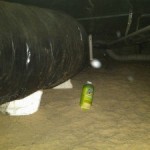Fogging for insects used to be the ‘bomb’ (pun intended) It was the end all cure all and even after a failed treatment the client would just be in utter amazement that an insect would live through such a complete and thorough dousing of their house rather than be upset with the technician. Hey maybe we should go back to it.
 For some companies years ago fogging was a regular and everyday thing but now I’m not so sure. There were the stainless steel type fog machines that looked similar to a 1950’s blender, the thermal unit that looks more like a gun from the movie Rambo and even the Micro-gen that you put what appeared to be a scientific beaker filled with a mysterious liquid in a case that could pass for film projector. All of these wild looking machines dispensed a ULV or ultra low volume of insecticide where ever you aimed them and any bug in its path was surely doomed. Pest control companies stocked each truck with these tools and charged extra anytime the need arose.
For some companies years ago fogging was a regular and everyday thing but now I’m not so sure. There were the stainless steel type fog machines that looked similar to a 1950’s blender, the thermal unit that looks more like a gun from the movie Rambo and even the Micro-gen that you put what appeared to be a scientific beaker filled with a mysterious liquid in a case that could pass for film projector. All of these wild looking machines dispensed a ULV or ultra low volume of insecticide where ever you aimed them and any bug in its path was surely doomed. Pest control companies stocked each truck with these tools and charged extra anytime the need arose.
Of course foggers are not exclusive to pest control professionals and you don’t need some fancy machine to send out a vaporous ‘cloud of death’ since they come in convenient little 4 to 6 ounce do it yourself can. Whether you are a pro or homeowner however there are a few things you should never do with foggers because one thing has remained the same;
6 things you should NOT do
Never use around open flames Newer materials may be less of a fire hazard but did you know that even particles of flour are extremely flammable? These tiny insecticide droplets are under pressure and have inert ingredients to help carry it which can and often does result in a bad situation when used around pilot lights or flames.
Never put more than the recommended amount of foggers in a structure. Doing so changes the name from fogger to BOMB! Literally.
Never put your fogger in a smaller space than what the label says it will treat. Once you click the can that things dispensing until it’s done. Putting a can under a sink or a tiny room will simply cause a mess, cause the heavy fog to possibly find hidden escapes routes and go to unintended areas and throw off any room re-entry recommendations which can cause inadvertent exposure.
Don’t put foggers in low crawl spaces or attics. In fact what are you doing in a crawl space anyway with a fogger? Let a pro do it with his Neanderthal machine from the entry point where everybody is a little safer. Foggers in low areas simply soak the surface above it and won’t spread out the way it’s intended. If possible, angle the can securely so it will shoot out and not build up in a mess directly overhead.
Never use a fogger without reading the safety precautions. I know pictures are great and if we see a flea or a roach pic on the can that’s all we need to know right? Wrong my friend, these innocent looking little cans have some powerful stuff inside and you need to know the details of what to wear for protection, how long to stay away and how much your can will treat.
Finally, Never throw the can into a room or area hoping it will do its job. I saw my buddy Billy The Exterminator do this in an episode where he had yellow jackets in a shed. It’s really not good and you can’t be guaranteed which way it’ll end up and besides being a waste it may be really unsafe.
Did I miss any? I’d like to hear what you have to say and any experiences you’ve had so the rest of us can benefit and all stay a little safer if indeed we have to use a bug bomb.

Leave a Reply